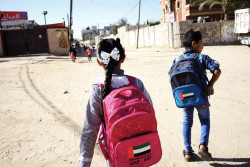メニュー 閉じる
- TOP
- はじめてのかたへ
- よくあるご質問/お問合せ
-
ユニセフについて
-
世界の子どもたちを知る
-
ユニセフハウス展示見学
- 協定地域組織(地域における活動)
- イベント一覧
- お知らせ一覧
- ご支援者(個人)の皆様へ
ユニセフについて
世界の子どもたちを知る
ユニセフハウス展示見学
 寄付方法のご案内
寄付方法のご案内
 ご寄付による支援例・成果
ご寄付による支援例・成果
 領収書
領収書
 その他のご協力方法
その他のご協力方法
 個人のみなさま
個人のみなさま
 学校・園のみなさま
学校・園のみなさま
 大学生ボランティア
大学生ボランティア
【2018年5月4日 アンマン(ヨルダン)発】
ガザで子どもたちが犠牲を強いられている現状について、ユニセフ(国連児童基金)中東・北アフリカ地域事務所代表ヘルト・カッペラエレが、以下の声明を発表しました。
* * *
 |
|
© UNICEF/UN0161246/d’Aki |
|
午後の部の授業を受けるため登校するタラル君(9歳)とサミラちゃん(7歳)。(2017年12月撮影) |
この5週間に、ガザで行われている多くは平和的に行われているデモで、子ども5人が死亡し、数百人が負傷しました。
すでに疲弊している保健システムは、停電や燃料・医薬品・機材の不足によりさらに悪化し、負傷した人々に治療を提供することが困難になっています。
子どもたちは身体的な傷に加えて、心にも深刻な悩みやトラウマを抱えている兆候を示しています。
昨日、ユニセフ・パレスチナ事務所の特別代表は、銃で撃たれ心臓近くに深刻な怪我を負った14歳の男の子を訪問しました。彼は病院で2週間治療を受けた後、今は家で療養しています。痛みを抱えながら楽観的になるのは難しいのですが、回復したならば、彼の命を助けてくれた医師のように自らも医師になりたいと言います。
ガザの暴力の激化は、すでに何年も耐えがたいほど厳しい状況下に生きることを強いられてきた子どもたちの苦しみをさらに厳しいものにしています。子どもたちの半数は人道支援に依存しており、4人に1人は心理社会的ケアを必要としています。
学校は生徒が多すぎるため3部制で運営されており、子どもたちの学習の機会を制限しています。
最低レベルでの電力しか供給されないガザでは、水と衛生のサービスは停止し、飲料水を入手することは極めて困難になり、10家族のうち9家族は日常的に安全な水を得ることができません。
ユニセフは、子どもたちの命を守る保健、水と衛生、教育、および保護の分野で今後も支援を続けていきます。
ユニセフは、影響力のあるすべての者に対して、子どもたちを守り、危険から遠ざけるよう、あらためて要求します。子どもたちは学校や家庭や公園にいるべきで、決して攻撃の対象にされたり、暴力への参加を促されてはならないのです。
【関連ページ】
シェアする
